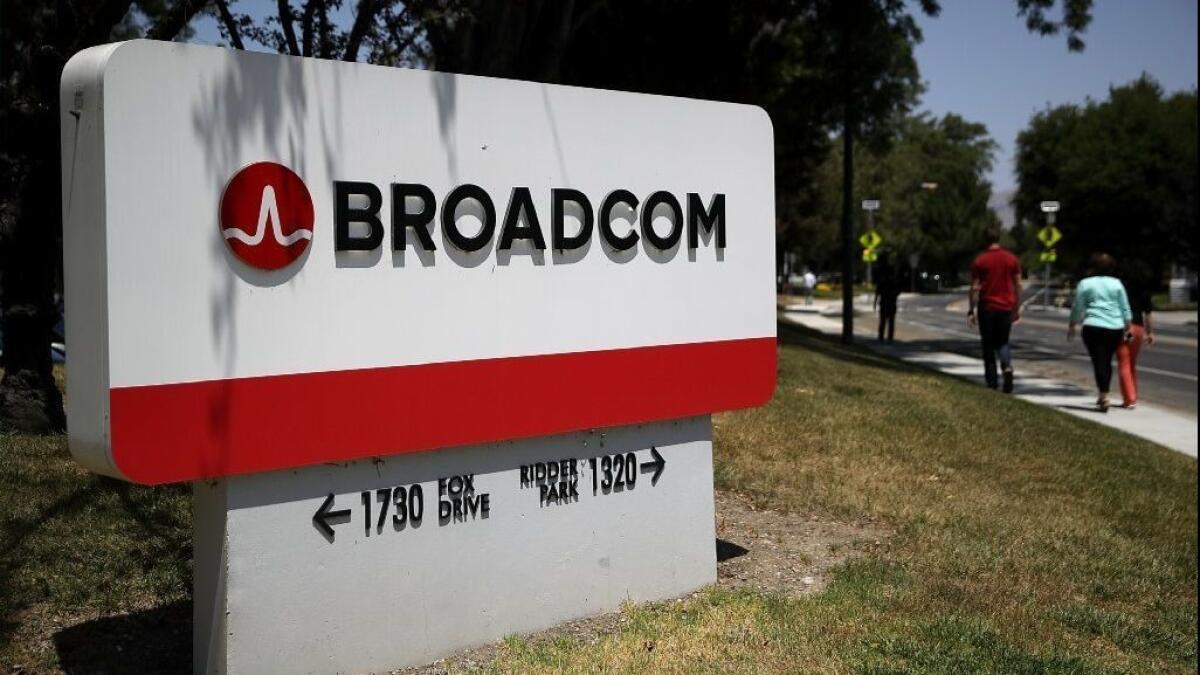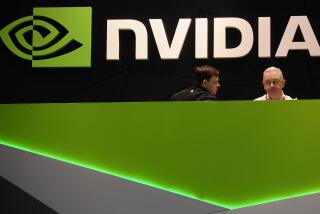Broadcom agrees to buy CA Technologies for $18.9 billion

- Share via
Broadcom Inc., a semiconductor maker whose acquisitions have reshaped the chip industry, agreed to acquire CA Technologies for $18.9 billion in cash, branching out into corporate software to diversify its business.
Broadcom will pay $44.50 a share, a 20% premium to CA’s closing price on Wednesday, the companies said in a statement after markets closed for the day. The deal will immediately add to Broadcom’s earnings once completed, which is expected in the fourth quarter.
Under Chief Executive Officer Hock Tan, Broadcom has transformed itself through a string of deals into one of the world’s largest chipmakers.
Last year, Tan launched an ambitious attempt to grow even bigger — through the purchase of rival mobile-chip maker Qualcomm Inc. That hostile takeover bid was blocked in March by the U.S government on national security grounds.
With a deal for CA, Broadcom will move into software used to manage business planning and other processes, adding a steady stream of recurring revenue from long-term contracts. The company implied that it will do more deals.
“This transaction represents an important building block as we create one of the world’s leading infrastructure technology companies,” Tan said in the statement. “We intend to continue to strengthen these franchises to meet the growing demand for infrastructure software solutions.”
Shares of New York-based CA were up 16% in extended trading following the announcement, which came after reports that a deal had been reached. Broadcom stock fell 5.6%.
After the rejection of its Qualcomm bid, the San Jose-based company — which relocated its headquarters to the United States from Singapore earlier this year — had said it would probably avoid large purchases and concentrate on returning cash to shareholders in the form of stock buybacks and dividends.
Broadcom plans to pay for the purchase with cash on hand plus $18 billion in new debt financing. The company said it expects its debt rating to remain at investment grade.
Tan has built Broadcom by acquiring what he calls franchises. He looks at targets and identifies units and businesses inside those companies that he believes have a sustainable advantage, makes an acquisition, then spins off or shutters everything else.
That has widened Broadcom’s profit margins by more than 20 percentage points since 2009 and earned him praise from the market.
CA Technologies, incorporated as CA Inc., has even better profitability. Broadcom’s gross margin, or percentage of sales remaining after deducting the cost of production, was 67% in its most recent quarter. CA was at 86%.
Still, Broadcom is a provider of components for computers, smartphones and networking equipment. CA’s software and services don’t directly overlap in any way.
“Legacy software assets are highly tangential to Broadcom’s core data-center and smartphone chip businesses,” said Bloomberg Intelligence analyst Anand Srinivasan. “Integration here would likely be harder and customer bases have little overlap.”
Diverging so far in terms of products may help the transaction avoid the same level of regulatory scrutiny that undid Tan’s attempted Qualcomm purchase. Winning the go-ahead from governments has become increasingly challenging in the chip industry, where the sensitive nature of the technology and its use in military equipment can lead lawmakers to block deals based on questions about national security.
CA makes software to manage IT operations, digital security and project management and for developing applications. The company traditionally made products that run on mainframes, but in recent years has entered the cloud computing market.
The software maker is cutting 800 jobs, it said in a regulatory filing in May, putting it in line with the cost-reduction measures that Tan usually employs.
The software maker has projected sales of $4.25 billion to $4.29 billion this fiscal year, which would represent a slight rise from fiscal 2018. Revenue climbed 5% in that period, and was little changed or fell for the five years prior to that.
In the fourth fiscal quarter, about half of the company’s revenue still came from solutions for mainframes, a type of computer that organizations have used to process vast amounts of data since the 1960s. That area contributes 90% of the company’s profit.
More to Read
Inside the business of entertainment
The Wide Shot brings you news, analysis and insights on everything from streaming wars to production — and what it all means for the future.
You may occasionally receive promotional content from the Los Angeles Times.









